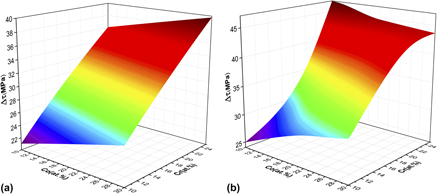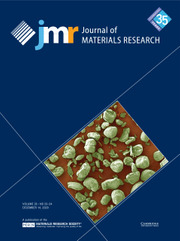Crossref Citations
This article has been cited by the following publications. This list is generated based on data provided by
Crossref.
Chu, Tongjiao
Xu, Huali
Cui, Haichao
and
Lu, Fenggui
2019.
Research on the coarsening mechanism of precipitations and its effect on toughness for nickel-based weld metal during thermal aging.
Journal of Materials Research,
Vol. 34,
Issue. 15,
p.
2705.
Mahajan, Amit
and
Sidhu, Sarabjeet Singh
2019.
In vitro corrosion and hemocompatibility evaluation of electrical discharge treated cobalt–chromium implant.
Journal of Materials Research,
Vol. 34,
Issue. 08,
p.
1363.
Asadikiya, Mohammad
Drozd, Vadym
Yang, Songge
and
Zhong, Yu
2020.
Enthalpies and elastic properties of Ni-Co binary system by ab initio calculations and an energy comparison with the CALPHAD approach.
Materials Today Communications,
Vol. 23,
Issue. ,
p.
100905.
Zhang, Jing
Korzhavyi, Pavel A.
and
He, Junjing
2020.
Investigation on elastic and thermodynamic properties of Fe25Cr20NiMnNb austenitic stainless steel at high temperatures from first principles.
Computational Materials Science,
Vol. 185,
Issue. ,
p.
109973.
Zhang, Jing
and
Korzhavyi, Pavel A.
2020.
First Principles Investigation on Thermodynamic Properties and Stacking Fault Energy of Paramagnetic Nickel at High Temperatures.
Metals,
Vol. 10,
Issue. 3,
p.
319.
Yin, Binglun
Yoshida, Shuhei
Tsuji, Nobuhiro
and
Curtin, W. A.
2020.
Yield strength and misfit volumes of NiCoCr and implications for short-range-order.
Nature Communications,
Vol. 11,
Issue. 1,
Wang, Yushuai
Wu, Xiaoxia
and
Narsu, B
2020.
Phase stability and mechanical property of γ′- (Ni1-xCox)3Al1-yCry alloys.
Materials Research Express,
Vol. 7,
Issue. 8,
p.
086519.
Marenych, Olexandra
and
Kostryzhev, Andrii
2020.
Strengthening Mechanisms in Nickel-Copper Alloys: A Review.
Metals,
Vol. 10,
Issue. 10,
p.
1358.
Yang, Zhibiao
Sun, Jian
Lu, Song
and
Vitos, Levente
2021.
A comparative study of solid-solution strengthening in Cr-Co-Ni complex concentrated alloys: The effect of magnetism.
Computational Materials Science,
Vol. 192,
Issue. ,
p.
110408.
Zhang, Jing
Korzhavyi, Pavel A.
and
He, Junjing
2021.
First-principles modeling of solute effects on thermal properties of nickel alloys.
Materials Today Communications,
Vol. 28,
Issue. ,
p.
102551.
Drozd, Vadym
Asadikiya, Mohammad
Yang, Songge
and
Zhong, Yu
2022.
Energy and mechanical properties predictions in Fe-Ni binary system by ab initio calculations.
Materials Today Communications,
Vol. 33,
Issue. ,
p.
104118.
Shen, Chunjian
Zhu, Zengwei
Zhu, Di
van Nisselroy, Cathelijn
Zambelli, Tomaso
and
Momotenko, Dmitry
2022.
Electrochemical 3D printing of Ni–Mn and Ni–Co alloy with FluidFM.
Nanotechnology,
Vol. 33,
Issue. 26,
p.
265301.
Aledealat, Khaled
Aladerah, Bilal
and
Obeidat, Abdalla
2022.
Magnetic properties of transition-metal atomic monolayer in nickel supercell: Density functional theory and Monte Carlo simulation.
Journal of Magnetism and Magnetic Materials,
Vol. 564,
Issue. ,
p.
170173.
Bui, Thi-Xuyen
Fang, Te-Hua
and
Lee, Chun-I
2022.
Investigation of the deformation behavior and mechanical characteristics of polycrystalline chromium–nickel alloys using molecular dynamics.
Journal of Molecular Modeling,
Vol. 28,
Issue. 10,
Wen, Zhuhao
Hu, Yunlong
Chen, Weimin
Zhang, Qiang
Zhang, Lijun
and
Du, Yong
2022.
High-throughput exploration of the composition-dependent elasto-plastic properties in Co–Ni–W system.
Journal of Alloys and Compounds,
Vol. 896,
Issue. ,
p.
163061.
Goto, Kenta
Ikeda, Ayako
Osada, Toshio
Watanabe, Ikumu
Kawagishi, Kyoko
and
Ohmura, Takahito
2022.
High-Throughput Evaluation of Stress–Strain Relationships in Ni–Co–Cr Ternary Systems Via Indentation Testing of Diffusion Couples.
SSRN Electronic Journal ,
Goto, Kenta
Ikeda, Ayako
Osada, Toshio
Watanabe, Ikumu
Kawagishi, Kyoko
and
Ohmura, Takahito
2022.
High-throughput evaluation of stress–strain relationships in Ni–Co–Cr ternary systems via indentation testing of diffusion couples.
Journal of Alloys and Compounds,
Vol. 910,
Issue. ,
p.
164868.
Xia, Fangfang
Xu, Weiwei
Shi, Zhenchuan
Xie, Wei
and
Chen, Lijie
2022.
Exploring the alloying effects on generalized stacking fault energy and ideal strength of Ni and Ni3Al phases in Ni-based superalloys.
Mechanics of Materials,
Vol. 165,
Issue. ,
p.
104183.
Liu, Peng
Yuan, Xinyi
Du, Yizhe
Long, Mujun
Duan, Huamei
and
Chen, Dengfu
2023.
Exploration of electrodeposited process of Ni-Co-Cr coating and investigation of Cr doping strengthening mechanism by indentation simulation.
Journal of Materials Processing Technology,
Vol. 311,
Issue. ,
p.
117818.
Zhang, Chao
Ya, Ruhan
Sun, Ming
Ma, Ruibin
Cui, Jingyi
Li, Zhipeng
and
Tian, Wenhuai
2023.
In-situ EBSD study of deformation behavior of nickel-based superalloys during uniaxial tensile tests.
Materials Today Communications,
Vol. 35,
Issue. ,
p.
105522.


